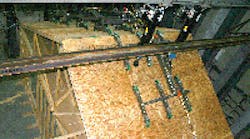Imagine knowing how well structural building components would stand up against an earthquake or hurricane without actually witnessing or experiencing the devastating loss and damage. Well, imagine no more, because The Wood Truss Council of America’s (WTCA) new Structural Building Components Research Institute (SBCRI) testing center, Madison, Wis., can now replicate real-world performance of construction products and systems unattainable at other testing facilities. Hydraulic actuators and monitoring sensors from Parker Hannifin Corp., Cleveland, Ohio, are being used to generate and collect force and position measurements.
SBCRI, a subsidiary of WTCA, tests on behalf of the structural building components industry and performs proprietary testing for outside companies as well. The facility is 5,730 sq. ft, with a testing area that is 30 x 32 x 90 ft. In other words, the area is large enough to test a 30 x 90-ft two-story house and the facility can test full-scale structures (including roof and floor trusses sitting on walls) as well.
The lab contains a structure of steel columns and beams that enables hydraulic actuators to be precisely arranged around components being tested. The actuators provide exact loads individually or simultaneously to simulate any lateral or gravity combination applied to a structure. Critical testing projects of cutting-edge materials and components — from trusses to wall panels, engineered lumber to fiber-reinforced products and light gauge steel, to name a few — are scheduled to examine the integrity and cost efficiency of buildings.
Typical industry testing focuses on the performance of single components and, in many cases, subsets of these components, such as a wall or section of roof trusses. But what happens when these components are, along with others, assembled in a system? SBCRI transcends these tests and coordinates results in a way that considers and evaluates load distribution when such components are assembled in a building system.
The research facility can test frameworks with applied loads and pressure that simulate conditions such as strong wind or seismic scenarios, snow, and wind uplift. During these tests, depending on testing combinations selected by the lab technician, hydraulic actuators apply loads simultaneously in vertical (gravity, uplift and cyclical) and horizontal (lateral, cyclic) planes – parallel with or perpendicular to the roof framing component being tested. Tests analyze a roof system and simulate loads created by the building’s own weight, high-wind lateral loads on the walls, and uplift loads on trusses; undulations in the testing lab’s floor system can easily simulate the actual lateral and vertical displacements that take place during an earthquake.
Keith Hershey, director of R&D for SBCRI, turned to Ritter Technology LLC, a Parker Hannifin distributor, for help with designing a hydraulic system capable of applying force in three axes simultaneously to simulate both construction and environmental loads. Ritter contacted Parker personnel for engineering assistance and the SBCRI/Ritter/ Parker team began designing the system for setup. The system design required servo valves, actuators, pumps, accumulators, a filtration system, cable harnesses, and field piping, all provided by Parker.
The initial design called for 52 2HX actuators mounted vertically to generate forces from 8 to 15,000 lb-ft, with 20-in. stroke lengths and position control down to 0.001 in. The actuator control also needed to be easily modifiable to meet unknown specifications for future, pioneering projects. As the team progressed through development, more than 10 different control functions were written for testing. For example, one test ramps the load on a roof up to the desired value more than three hours to simulate snow loading.
Eight horizontal actuators control the applied load function in sinusoidal motion to simulate standardized earthquake loads. The engineering team also designed the hydraulic system with the capability to add up to 206 additional actuators so the system can evolve as new testing configurations are developed. Delta Computer Systems, Vancouver, Wash., was selected for the motion controller hardware.
Parker brought Adamation, a controls integrator based in Maumee, Ohio, on board to develop software. A distributed control system provides test parameter setup and synchronous actuator control, and collects all load distributions and deflections of the item being tested. For the safety of operators and components, E-stop stations around the testing area immediately halt and lock all hydraulic pumps and actuators when pressed.
The loading-actuator controls are designed to be as universal as possible and the architecture is open for additional control schemes in the future. Currently, five control panels command 60 axes of position and force with room for growth as necessary. The testing system’s motion controllers can be moved nearer to actuators along the lab’s rail system. Twelve cylinders connect to each motion control enclosure. Actuators, cable harnesses, and controllers have barcode labels enabling operators to scan location, tuning, and scaling parameters for each actuator. SBCRI says that information obtained from the enhanced level of testing provided by the facility will lead to more efficient design, installation, and use of all structural building components.
For more information, visit Parker Hannifin Corp.

